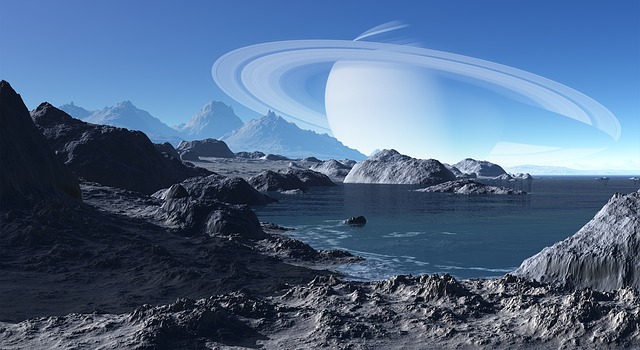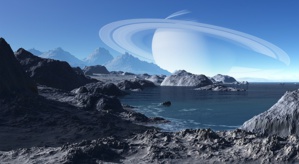Since the year of 2004, N.A.S.A has launched its “Cassini spacecraft” for finding more about Saturn, which till date is orbiting around the planet and its moons. Recently, the spaceship “confirmed” that Saturn’s moon Titan has “a huge sea” not of water but “mostly of pure liquid methane”.
The said sea has been named Ligeia Mare which spreads across an area of 126,000 sq. Kms. Moreover, Cassini also reports that there could be “a sludge of carbon- and nitrogen-rich material” covering the sea bed, while the shores could have a surrounding of wetlands.
TOI writes:
“Methane, a compound made of one carbon atom and four hydrogen atoms, exists as a gas on Earth. It becomes liquid only at -161.5 degrees Celsius. Saturn's great distance from the Sun ensures that gases like methane exist as liquids there”.
So far, Cassini has explored over “1.6 million square kilometres” of Titan’s surface “covered in liquid” which accounts for only two percent of the total surface area. The gigantic moon possesses “three large seas” all of which are found near its north pole. There are also numerous “smaller lakes in the northern hemisphere”, while only one large lake is present in the other hemisphere.
In the year of 2014, with the help of Cassini’s radar instrument, it was found that the sea Ligeia Mare is rich in methane. The Deputy Lead in the Cassini Radar Team, Steve Wall, said:
"It's a marvelous feat of exploration that we're doing extraterrestrial oceanography on an alien moon”.
While, an associate from the “French research laboratory LATMOS, Paris”, Alice Le Gall, who also authored a new research work on the same subject, stated:
"Before Cassini, we expected to find that Ligeia Mare would be mostly made up of ethane, which is produced in abundance in the atmosphere when sunlight breaks methane molecules apart. Instead, this sea is predominantly made of pure methane”.
Alice Le Gall’s study bases itself on the data collected from “Cassini's radar instrument” between the period of 2007 to 2015. Le Gall claims that there could multiple explanations for the presence of a methane sea in Titan:
"Either Ligeia Mare is replenished by fresh methane rainfall, or something is removing ethane from it. It is possible that the ethane ends up in the undersea crust, or that it somehow flows into the adjacent sea, Kraken Mare, but that will require further investigation."
"We found that the seabed of Ligeia Mare is likely covered by a sludge layer of organic-rich compounds”.
Furthermore, the study also states that the shoreline of Ligeia Mare could be porous and flooded with liquid hydrocarbons”. However, the data from Cassini show no temperature difference between the sea and its shore, whereby suggesting the fact that “the terrains surrounding the lakes and seas are wet with liquid hydrocarbons, which would make them warm up and cool down much like the sea itself”.
References:
http://timesofindia.indiatimes.com/
The said sea has been named Ligeia Mare which spreads across an area of 126,000 sq. Kms. Moreover, Cassini also reports that there could be “a sludge of carbon- and nitrogen-rich material” covering the sea bed, while the shores could have a surrounding of wetlands.
TOI writes:
“Methane, a compound made of one carbon atom and four hydrogen atoms, exists as a gas on Earth. It becomes liquid only at -161.5 degrees Celsius. Saturn's great distance from the Sun ensures that gases like methane exist as liquids there”.
So far, Cassini has explored over “1.6 million square kilometres” of Titan’s surface “covered in liquid” which accounts for only two percent of the total surface area. The gigantic moon possesses “three large seas” all of which are found near its north pole. There are also numerous “smaller lakes in the northern hemisphere”, while only one large lake is present in the other hemisphere.
In the year of 2014, with the help of Cassini’s radar instrument, it was found that the sea Ligeia Mare is rich in methane. The Deputy Lead in the Cassini Radar Team, Steve Wall, said:
"It's a marvelous feat of exploration that we're doing extraterrestrial oceanography on an alien moon”.
While, an associate from the “French research laboratory LATMOS, Paris”, Alice Le Gall, who also authored a new research work on the same subject, stated:
"Before Cassini, we expected to find that Ligeia Mare would be mostly made up of ethane, which is produced in abundance in the atmosphere when sunlight breaks methane molecules apart. Instead, this sea is predominantly made of pure methane”.
Alice Le Gall’s study bases itself on the data collected from “Cassini's radar instrument” between the period of 2007 to 2015. Le Gall claims that there could multiple explanations for the presence of a methane sea in Titan:
"Either Ligeia Mare is replenished by fresh methane rainfall, or something is removing ethane from it. It is possible that the ethane ends up in the undersea crust, or that it somehow flows into the adjacent sea, Kraken Mare, but that will require further investigation."
"We found that the seabed of Ligeia Mare is likely covered by a sludge layer of organic-rich compounds”.
Furthermore, the study also states that the shoreline of Ligeia Mare could be porous and flooded with liquid hydrocarbons”. However, the data from Cassini show no temperature difference between the sea and its shore, whereby suggesting the fact that “the terrains surrounding the lakes and seas are wet with liquid hydrocarbons, which would make them warm up and cool down much like the sea itself”.
References:
http://timesofindia.indiatimes.com/






